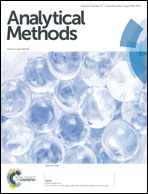Sensitive detection of Pb(ii) at gold nanoparticle/polyaniline/graphene modified electrode using differential pulse anodic stripping voltammetry
Abstract
In this work, a gold nanoparticle/polyaniline/graphene ternary nanocomposite modified glassy carbon electrode (GNP/PANI/GR/GCE) was prepared and characterized by scanning electron microscopy, spectroscopic techniques, and electrochemical techniques. It was found that the GNP/PANI/GR nanocomposite exhibited a good synergetic effect on the electrochemical signal from Pb2+, which is more efficient than that of electrodes modified with the individual materials. The modified electrode could be applied in the sensitive detection of Pb2+ by differential pulse anodic stripping voltammetry (DPASV). Several experimental parameters, such as the ratio of aniline/graphene, the amount of suspension modified on the electrode, the pH, the diameter of gold nanoparticles, the deposition time, and the potential of Pb2+ were optimized. Under the optimal conditions, a good linear relationship between the stripping peak currents and the concentration of Pb2+ was obtained in the range of 0.5 to 10 nM with a correlation coefficient of 0.9995 and a detection limit of 0.1 nM. The proposed method is applicable in the determination of trace Pb2+ in real water samples with a relative standard deviation less than 3.5% and recovery rates of ∼99%.


 Please wait while we load your content...
Please wait while we load your content...